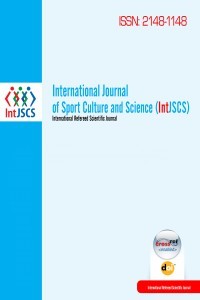Team Identity and Indirect Sport Consumption of Soccer Fans
Media Consumption, Merchandise Consumption, Soccer Fans, Team Identity,
___
- Armstrong G, Hognestad H (2003). "We're Not from Norway": Football and Civic Pride in Bergen, Norway. Identities: Global Studies in Culture and Power, 10(4), 451-475.
- Bairner A (2008). Sport, nationalism and globalization: Relevance, impact, consequences. Hitotsubashi journal of arts and sciences, 49(1), 43-53.
- Bogdanov D (2011). Influence of national sport team identity on national identity. (Doctor of Philosophy), the Florida State University.
- Bourdieu P (1998). Practical reason: On the theory of action: Stanford University Press .
- Boyle B A, Magnusson P (2007). Social identity and brand equity formation: A comparative study of collegiate sports fans. Journal of Sport Management, 21(4), 497-520.
- Carlson B D, Todd Donavan D, Cumiskey K J (2009). Consumer-brand relationships in sport: brand personality and identification. International Journal of Retail and Distribution Management, 37(4), 370-384.
- Decrop A, Derbaix C (2010). Pride in contemporary sport consumption: a marketing perspective. Journal of the Academy of Marketing Science, 38(5), 586-603.
- Fink J S, Parker H M, Brett M, Higgins J (2009). Off- field behavior of athletes and team identification: Using social identity theory and balance theory to explain fan reactions. Journal of Sport Management, 23(2), 142-155.
- Fornell C, Larcker D F (1981). Evaluating structural equation models with unobservable variables and measurement error. Journal of marketing research, 18(1), 39-50.
- Gau L S, James J D, Kim J C (2009). Effects of team identification on motives, behavior outcomes, and perceived service quality. Asian Journal of Management and Humanity Sciences, 4(2-3), 76-90.
- Goudarzi M, Farahani A, Alidoust E, Jalal Manesh A (2011). Studying the religious and national identity of the wrestlers and footballers of Tehran city. Olympic, 18(3), 21-31.
- Hair J, Anderson R, Black B, Babin B (2009). Multivariate Data Analysis. New Jersey: Prentice Hall.
- Heere B, James J D (2007). Stepping outside the lines: Developing a multi-dimensional team identity scale based on social identity theory. Sport Management Review, 10(1), 65-91.
- Kwon H H, Trail G T, Anderson D S (2005). Are multiple points of attachment necessary to predict cognitive, affective, conative, or behavioral loyalty? Sport Management Review, 8(3), 255-270.
- Melnick M J, Wann D L (2011). An examination of sport fandom in Australia: Socialization, team identification, and fan behavior. International Review for the Sociology of Sport, 46(4), 456-470.
- Reding F N (2009). Examining the team identification of football fans at the high school level. Western Kentucky University.
- Rowe D, Gilmour C (2010). Sport, media, and consumption in Asia: A merchandised milieu. American behavioral scientist, 53(10), 1530-1548.
- Shaji R, Shohrabi M, Fooladiyan J (2011). Determining the hierarchy of identity among the players of national handball teams of Iran and its relationship with sport identity, age, and heroic history. Olympic, 18(2), 113-124.
- Summers J, Morgan M (2006). The impact of parental style on sports consumption preferences of teenagers: an exploratory investigation in the Asia Pacific region. Asian Journal of Marketing, 12(1), 23-34.
- Sutton W A, McDonald M A, Milne G R, Cimperman J (1997). Creating and fostering fan identification in professional sports. Sport Marketing Quarterly, 6(1), 15-22.
- Veblen T (2005). The theory of the leisure class; an economic study of institutions: Aakar Books.
- Wann D L, Branscombe N R (1990). Die-hard and fair-weather fans: Effects of identification on BIRGing and CORFing tendencies. Journal of Sport and Social issues, 14(2), 103-117.
- Wann D L, Grieve F G (2005). Biased evaluations of in-group and out-group spectator behavior at sporting events: The importance of team identification and threats to social identity. The Journal of social psychology, 145(5), 531-546.
- ISSN: 2148-1148
- Başlangıç: 2013
- Yayıncı: Uluslararası Bilim Kültür ve Spor Derneği (UBİKS)
Tekmil Sezen GÖKSU, Oktay AKYÜZ
Özcan SAYGIN, Halil İbrahim CEYLAN, Ahmet Rahmi GÜNAY
Behnam NAGHI-POUR GIVI, Ehsan MOHAMADI TURKMANI, Abbas NAZARIYAN MADAVANI, Amir HOSSEIN MONAZZAMI
Ökkeş Alpaslan GENÇAY, Selçuk GENÇAY, Seda AVNİOĞLU, Yunus GÜR, Ertuğrul GENÇAY
Hüseyin ÖZTÜRK, Serkan HACICAFEROĞLU, Zeynep YILMAZ ÖZTÜRK
Michalis MITROTASIOS, Athanasios SOUGLIS, Aristotelis GIOLDASIS, Nikolaos KESARIS, Triantafillos KAMPOURIS
